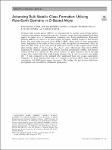Item Infomation
Full metadata record
| DC Field | Value | Language |
|---|---|---|
| dc.contributor.author | Pajor, Krzysztof | - |
| dc.contributor.author | Gondek, Łukasz | - |
| dc.contributor.author | Tyrała, Dorota | - |
| dc.date.accessioned | 2023-10-05T01:57:22Z | - |
| dc.date.available | 2023-10-05T01:57:22Z | - |
| dc.date.issued | 2023 | - |
| dc.identifier.uri | https://link.springer.com/article/10.1007/s11661-023-07176-9 | - |
| dc.identifier.uri | https://dlib.phenikaa-uni.edu.vn/handle/PNK/9462 | - |
| dc.description | Cc-BY | vi |
| dc.description.abstract | Zr-based bulk metallic glasses (BMGs) are characterized by excellent glass-forming ability, combined with superior mechanical properties. However, oxygen impurities degrade both these aspects as oxides serve as heterogeneous nucleation sites during solidification. Rare-earth elements (REEs) are known to be good oxygen scavengers, binding oxygen to less harmful forms. The most stable rare-earth oxide (REO) is M2O3, which occurs in three polymorphic forms, depending on the radius of metal cation: cubic, hexagonal, and monoclinic. Here, we show the effect of Sc, Y, Lu, Nd, and Gd additions in relation to the oxygen content on the glass-forming ability of the Zr52.5Cu17.9Ni14.6Al10Ti5 alloy. Microscopic observations (SEM) supported by chemical analysis (EDS, WDS), structure identification (XRD), and thermal analysis (DTA) were carried out. | vi |
| dc.language.iso | en | vi |
| dc.publisher | Springer | vi |
| dc.subject | XRD | vi |
| dc.subject | DTA | vi |
| dc.title | Advancing Bulk Metallic Glass Formation: Utilizing Rare-Earth Elements in Zr-Based Alloys | vi |
| dc.type | Book | vi |
| Appears in Collections | ||
| OER - Khoa học Vật liệu, Ứng dụng | ||
Files in This Item:

